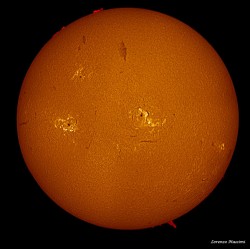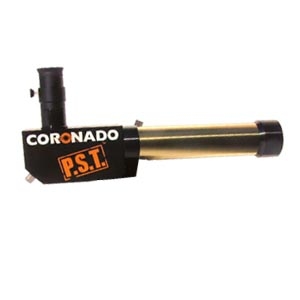[/caption]Are you interested in taking an in-depth look at our nearest star in a specific wavelength of light? H-alpha has a wavelength of 656.281 nanometers and is visible in the red part of the electromagnetic spectrum. A hydrogen-alpha filter is an optical filter designed to transmit a narrow bandwidth of light generally centered on the H-alpha wavelength. These special filters are great, but they are difficult to use because of temperature and f-ratio requirements… not to mention expense! If you’ve ever been curious as to whether or not a Coronado PST was worth the price, then follow along.
At around $500, the Coronado Personal Solar Telescope isn’t an investment you take lightly for such limited use. Because almost all telescopes and binoculars can be outfitted with a relatively inexpensive white light solar filter, it’s almost an extravagance to view in this manner – or is it? For those who are able to afford specific Ha filters to fit their existing refractor telescopes, the luxury provides an incredible wealth of details unseen in white light – but also opens up a world of over-heating and sensitive adjustments. It’s a scary thought to trust your permanent vision to a tiny piece of glass, but human curiosity is what it is. There are those of us who want and need more…
So enter the Coronado H-Alpha Personal Solar Telescope. For years I’ve wanted to get my hands on an h-alpha solar filter and the thought of having a dedicated solar telescope was simply too good to pass up. The refractor telescopes I own were meant for nighttime viewing and I knew this milled aluminum beauty was meant for only one thing – the Sun. But would this amazingly small little gold telescope give me everything that I had hoped for? All I needed was a sunny day…
Setting up a Coronado PST was everything it was promised to be. It is no more difficult to use than a spotting scope and the built-in “Sun Finder” is definitely a bit easier than using the shadow-aim method. Happy as a little clam, I draped a black towel over my head and bent to the eyepiece. I kept sliding the focus up and down, but was met with nothing but a rotten, blurry image. Where’s this great solar telescope, huh? Where’s the excitement? I was disapointed at first.
But it wasn’t the telescope’s fault… It was mine.

Over a period of several months, the Coronado PST and I have done a lot of exploring. I’ve learned to identify plages and fibrils. I’ve seen prominences and filaments. What sunspots there are have taken on a whole new dimension. The PST has awakened my curiosity to what can be observed with even more sophisticated equipment! Was it worth what it cost?
Every last cent…
Note to Readers: The Coronado Personal Solar Telescope used for this review was purchased at Oceanside Photo and Telescope – an exclusive Coronado dealer.


With an H-alpha scope you can see the happenings on the most dynamic object you can view through a telescope. The Sun is different everyday. You can watch it change over minutes. And right now it’s relatively quiet. As for the price? You can use it every clear day. Think about it. Compared to nighttime observing, you get far more use (or potential use).
If you think the view is good through the PST, get hooked and look through a Maxscope 60 or my friend’s double stacked Maxscope 90 with a binoviewer!
I think solar observing is an area that is really going to open up to amateurs soon. Up until the PST came out, it was an expensive preserve of the rich and/or obsessed. Now we have the PST, and other manufacturers out on the market such as Lunt, who are offering quite incredible prices on their scopes. Competition is always good in this business. The Coronado Solarmax scopes are even coming down in price. So I think the price of a solar instrument is starting to get to that tipping point where everyone (everyone who is astronomically inclined, that is) with a bit of spare cash will potentially be able to get into the game. And a great game it is – the Sun is an awe-inspiring object to observe!
What about the rust bug in the filters?
Good concept spoiled by production quality.
Hi, Andy…
I’m very glad you brought that up. For those not acquainted with what Andy’s asking, there’s been an issue with degradation of the coatings on the etalon (the primary filter lens). It was a problem I was aware of and I’m delighted to address it even though it hasn’t occured to my PST!
The PST uses a cemented doublet achromatic lens assembly for its objective. (If you’re curious about how that works, check out “Refractor Telescope” in Guide To Space.) Some of the first PSTs to come out (and this is over a few years – not just a few beginning models) had silver (colored) coatings that over a period of time displayed a “weirdness” in the lens assembly. Some saw it as a discoloration, others saw as spots, some saw it as rust – but what it all boiled down to was not the coatings that had failed, but the cement between the lenses! The view was still fine, and still safe to the eyes – but at what it costs, was unacceptable.
Fortunately, the Coronado branch of Meade (why aren’t we suprised here?) took full responsibility for the problem, took all the faulty scopes back and replaced the etalon. These newer “replacements” show a blue looking coloration to the lens coatings and so far have proved stable. This is also one of the reasons I highly suggest that anyone interested in purchasing a Coronado PST do so through an authorized dealer. If you ever have a problem, it will be fixed – no questions asked and no hassles given.
I hope this clarifies an issue that I haven’t experienced with a late 2007 model purchased from the noted dealer (who goes out of their way to put customers first and wouldn’t send you one that had been on the shelf since then). I also invested in the Cemax eyepieces at the same time – but they need a review of their own!
Again, thank you for pointing out this issue. I didn’t feel it fair to include it in my review because the problem appears to have been solved – but I’m very, very glad to address it so that folks won’t be tempted to buy a PST on eBay or a similar source.
I know it’s fun to see things for yourself, but at $500, I’m not sold on the “worth every last cent” statement. For $40 a month, you can get a fast internet connection which gives you near real time access to images of the Sun at the SOHO website:
http://sohowww.nascom.nasa.gov/data/realtime/eit_304/1024/latest.html
These are excellent, have looked through a few and want one, perhaps one day?
I’ll become the owner of a 60mm Luntscope by fall and am really looking forward to viewing the sun at my own leisure with a Hydrogen alpha filter double stacked. Aside from the above postings’mentioned benefits is the ability to show off the sun’s features just about anywhere at convenient times for children in the neighborhood.
Reading Tammy’s reply above has made me wonder why they use an achromatic doublet at all; the light passed by the narrow-band filter is as near monochromatic as makes no difference.
The old versions of the PST had rust problems ( coating serperation). The new ones or the upgraded ones are fine.
The old versions of the PST had rust problems ( coating seperation). The new ones or the upgraded ones are fine.
Those of you financing the development of the Lunt Ha scopes, I hope you see something someday. I’ll wait for Lunt 2.0 thanks.
Hey Jeff,
Why wait? I just got my hew Lunt LS60THa and it is wonderful. Absolute perfection in the construction. A true piece of engineering.
I’ve owned a PST for two years, which I’ve used a lot, and really enjoyed. For the money, Lunt has a real winner in the LS60THa.